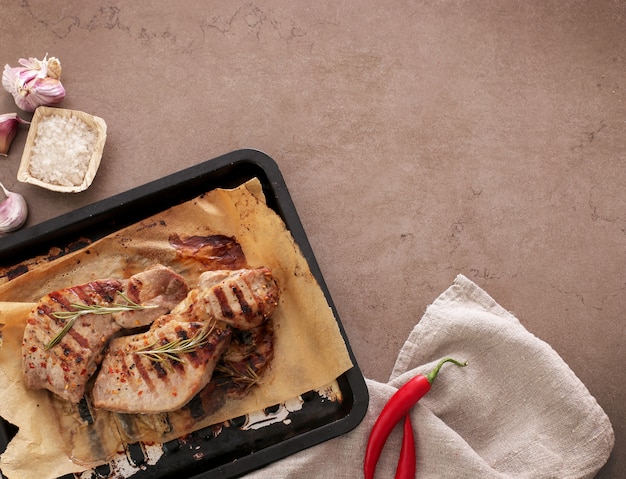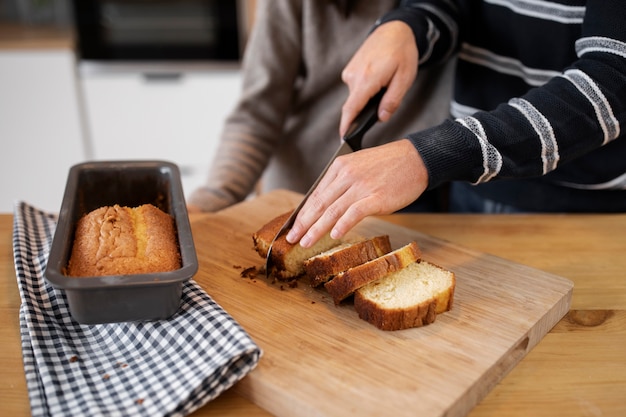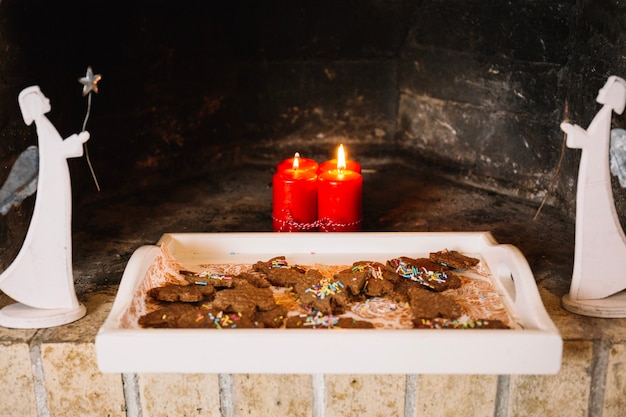Let's talk ribs, folks! Specifically, those melt-in-your-mouth, fall-off-the-bone, oven-baked spare ribs. You know, the kind that makes your taste buds sing and your heart happy? There's a reason they're a classic – they're just plain delicious!
Now, I've been on a bit of a rib journey myself. I've tried every method under the sun, from smoking to grilling, but nothing beats the simplicity and sheer deliciousness of oven-baked ribs. It's a method that's foolproof, forgiving, and delivers incredible results every time.
This ultimate guide is your one-stop shop for all things oven-baked spare ribs. We'll explore everything from choosing the right cut of meat to mastering the perfect rub and sauce. I'm going to share my personal secrets, tips, and tricks, so you can achieve ribs that are so tender, juicy, and flavorful, you'll be the envy of all your friends and family.
So, put on your apron, crank up the music, and let's get cooking!
(Part 1) The Anatomy of a Spare Rib

You might think all ribs are created equal, but there's a little more to it than that. Understanding the anatomy of a spare rib is crucial to achieving that incredible melt-in-your-mouth tenderness.
Spare Ribs vs. Baby back ribs
Let's get this straight right off the bat – spare ribs and baby back ribs are not the same thing. They're like the yin and yang of the rib world, each with their own unique characteristics.
Spare Ribs: These are the bigger, bolder ribs, hailing from the lower part of the pig's rib cage. They're known for their meatier, more substantial feel, and often come with a more generous layer of fat, giving them a rich, savory flavor. They're also typically more affordable than their baby back counterparts.
Baby Back Ribs: These are the smaller, more delicate ribs, coming from the upper part of the pig's rib cage. They tend to be leaner and offer a more tender texture. They're also considered a bit more "refined," making them a popular choice for fancy dinners.
For our oven-baked journey, we're focusing on spare ribs. They're a real powerhouse of flavor, with a good balance of meat and fat, making them perfect for a beginner-friendly, oven-baked adventure.
The Structure of a Spare Rib
Now, let's take a closer look at the spare rib itself. It's a beautiful thing, isn't it? A symphony of individual ribs, each connected by a thin layer of fat and cartilage. This fat, my friends, is the key to our tenderness. It acts like a natural insulator, keeping the ribs juicy and flavorful during the cooking process. You can think of it as the rib's personal moisturizer – keeping it plump and happy.
(Part 2) Choosing the perfect ribs

You're ready for a rib adventure! Now, let's pick the perfect rack to set off on this delicious journey.
Look for a Nice, Thick Cut
When you're at the butcher's counter, look for ribs that are at least 1 1/2 inches thick. It's like choosing a juicy steak – you want that extra thickness to ensure there's enough fat to keep the ribs moist and tender throughout the cooking process.
Check the Fat Layer
Don't be afraid of fat! It's your friend, your ally in this rib quest. A nice, even layer of fat over the ribs indicates they'll be juicy and flavorful. Think of it as a natural flavor booster and moisture retainer. You can trim off any excess fat later if you like, but don't remove it all – we want to keep that natural flavor and moisture locked in.
Look for a Uniform Cut
If you're buying pre-cut ribs, check that they are uniformly cut and that all the ribs are connected. This ensures they'll cook evenly, and you'll end up with a beautiful, cohesive rib rack.
(Part 3) Preparing the Ribs for Oven-Baked Perfection

Alright, we've got our beautiful ribs. Now it's time to get them ready for the oven.
Trim the Membranes
This might sound a bit intimidating, but it's actually very simple. It's all about prepping your ribs for a smooth, tender experience. The membrane, a thin, tough layer on the back of the rib rack, can act like a barrier, preventing the ribs from getting tender and juicy.
To remove it, grab a sharp knife and find the edge of the membrane. Carefully slide the knife under the membrane and lift it up. You can use a paper towel to get a better grip. Once you have a good hold, pull the membrane off in one piece.
Give Them a Good Wash
Rinse the ribs under cold running water to remove any loose debris. Pat them dry with paper towels, ensuring they're ready for their flavor-infused makeover.
Make a Flavor-Packed Rub
The key to awesome ribs is a delicious rub. Think of it as the secret weapon that transforms ordinary ribs into something extraordinary. Here's a basic recipe that you can customize to your liking:
- 1/2 cup smoked paprika
- 1/4 cup brown sugar
- 1/4 cup kosher salt
- 1/4 cup black pepper
- 2 tablespoons garlic powder
- 2 tablespoons onion powder
- 1 tablespoon chili powder
- 1 tablespoon dried thyme
- 1 tablespoon dried oregano
Combine all the ingredients in a bowl and mix well. Gently rub the mixture all over the ribs, making sure to get it into all the cracks and crevices. You can also add additional flavorings like cayenne pepper for a kick, or a touch of cumin or coriander for a more complex taste.
Let the Ribs Rest
Once your ribs are rubbed, cover them tightly with plastic wrap and refrigerate for at least 4 hours, or up to overnight. This gives the rub time to infuse the ribs with flavor and helps to tenderize the meat.
Think of it as a culinary meditation – allowing the flavors to mingle and create a harmonious symphony of taste.
(Part 4) The Oven-Baked Magic
Finally, it's time to get those ribs into the oven!
Prepping the Oven
Preheat your oven to 300 degrees Fahrenheit (150 degrees Celsius). Line a baking sheet with aluminum foil and place a wire rack over the foil. This will prevent the ribs from sitting in their own juices and ensure they cook evenly. It's like creating a little rib sanctuary, where they can cook to perfection without getting soggy.
Baking Time
Place the ribs on the wire rack and bake for 2-3 hours, or until the meat is incredibly tender and pulls away easily from the bone. You want the ribs to be so tender that they basically fall apart.
Patience is key here, my friends. It's a slow and steady process, allowing the magic of the oven to work its wonders.
The Importance of Basting
Every hour or so, check the ribs and baste them with a delicious barbecue sauce. This keeps them moist, adds more flavor, and creates a beautiful glaze. It's like giving your ribs a little love every hour, ensuring they stay juicy and irresistible.
(Part 5) Mastering the Sauce
Barbecue sauce is the final touch that takes your ribs from good to absolutely incredible. It's the crowning glory, the pièce de résistance, the cherry on top.
Choose Your Sauce
There are countless barbecue sauces available, so take your pick! If you're feeling adventurous, try making your own. Here's a basic recipe that you can customize to your taste:
- 1 cup ketchup
- 1/2 cup brown sugar
- 1/4 cup apple cider vinegar
- 1/4 cup Worcestershire sauce
- 2 tablespoons Dijon mustard
- 1 tablespoon smoked paprika
- 1 tablespoon garlic powder
- 1 teaspoon black pepper
Combine all the ingredients in a saucepan and bring to a simmer over medium heat. Cook for 5 minutes, stirring occasionally, until the sauce thickens slightly.
Adding the Sauce
About 30 minutes before the ribs are done, brush them generously with barbecue sauce. Continue basting every 15 minutes or so until the ribs are cooked through and the sauce is caramelized and sticky. It's a love affair in the oven – a slow, sweet, and sticky embrace.
(Part 6) Resting and Serving
Your ribs are out of the oven and looking absolutely magnificent. Don't rush the process!
Let Them Rest
Once the ribs are done, remove them from the oven and let them rest for at least 15 minutes before slicing. This allows the juices to redistribute, resulting in even more tender and flavorful ribs. It's a little bit of culinary zen – giving the ribs a chance to relax and settle into their ultimate state of deliciousness.
Serving Time
Now for the best part – it's time to serve your ribs! Here are a few ideas:
Classic Ribs: Serve the ribs on a platter with a side of coleslaw, baked beans, and potato salad. It's a classic for a reason – simple, satisfying, and always a hit.
Rib Sandwich: Pile the ribs on toasted buns with your favorite toppings. A perfect fusion of comfort and flavor.
Rib Tacos: Shred the ribs and use them to fill tortillas with your favorite toppings. A delicious twist on a classic, perfect for a casual gathering.
(Part 7) Tips and Tricks for Rib Success
Here are some of my personal tips and tricks that will help you achieve rib perfection:
Use a meat thermometer: To ensure your ribs are cooked through, use a meat thermometer to check the internal temperature. Ribs are done when the internal temperature reaches 190 degrees Fahrenheit (90 degrees Celsius). It's a scientific approach to ensuring your ribs are cooked to juicy perfection.
Don't Overcook: Overcooked ribs will be dry and tough. Keep a close eye on them and adjust the baking time if necessary. Remember, it's a delicate dance – we're aiming for tender, not dry.
Don't Be Afraid to Experiment: Get creative with your rubs and sauces. Try different flavors and spice levels to find what you like best. This is where you can unleash your culinary creativity and find your personal rib-tastic signature.
Don't Skip the Resting Time: This step is crucial for tender, juicy ribs. It's a chance for the ribs to relax, reabsorb their juices, and reach their ultimate level of tenderness.
(Part 8) The Aftermath: The Sweetest Part
You've done it! You've created a rib masterpiece. Now, enjoy the fruits of your labor with a big plate of fall-off-the-bone goodness. You'll be the envy of all your friends and family.
FAQs
What if my ribs are too dry?
If your ribs are a little dry, don't despair! You can add some moisture back in by brushing them with a little extra barbecue sauce or by wrapping them in foil for the last 30 minutes of cooking. A little extra TLC can go a long way in restoring those ribs to their former glory.
Can I make ribs ahead of time?
Absolutely! You can prepare the ribs up to 24 hours in advance. Just cover them tightly with plastic wrap and refrigerate. It's perfect for a stress-free dinner party or a relaxing weekend meal.
How can I tell if my ribs are done?
The best way to tell if your ribs are done is by using a meat thermometer. They should reach an internal temperature of 190 degrees Fahrenheit (90 degrees Celsius). You can also check for tenderness by gently pulling on a rib bone. If the meat easily pulls away from the bone, they're ready to go. It's a test of tenderness, ensuring your ribs are ready for their starring role in your culinary masterpiece.
What if my ribs are too salty?
If your ribs are too salty, you can try soaking them in cold water for 30 minutes before cooking. This will help to draw out some of the salt. Sometimes, a little salt bath can be the answer to a salty situation.
What are the best side dishes to serve with ribs?
The possibilities are endless! Classic side dishes like coleslaw, baked beans, potato salad, and corn on the cob are always a great choice. You can also get creative with other options like mac and cheese, sweet potato fries, or even a fresh green salad. There's a side dish out there for every rib lover, so get creative and create the perfect pairing.
There you have it, folks! That's your complete guide to creating oven-baked spare ribs that are tender, flavorful, and absolutely irresistible. So grab your apron, put on some music, and get ready to experience the joy of perfect ribs. And remember, if you ever have any questions, don't hesitate to reach out. I'm always here to help you on your rib-tastic journey.
Everyone is watching

How to Cook Frozen Lobster Tails Perfectly: A Step-by-Step Guide
RecipesLobster. Just the word conjures up images of lavish meals, special occasions, and a taste of luxury. But let's...

Pigs in a Blanket Cooking Time: How Long to Bake for Perfect Results
RecipesAh, pigs in a blanket. Just the name conjures up images of those delightful little parcels of crispy pastry en...

Pork Fillet Cooking Time: How Long to Cook It Perfectly
RecipesPork fillet, or tenderloin as it's sometimes called, is a real favourite in our house. It's so versatile, and...

The Ultimate Guide to Tender, Juicy Pulled Pork
RecipesRight, let's talk pulled pork. It's one of those dishes that just screams "comfort food," doesn't it? I mean...

The Ultimate Guide to Cooking Sweet Potatoes: From Roasting to Mashing
RecipesSweet potatoes. Just the name conjures up images of warm, comforting dishes, bursts of vibrant color, and a to...
